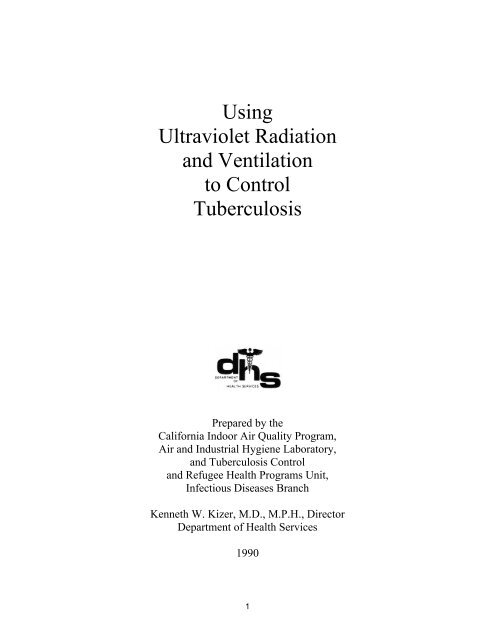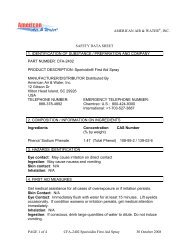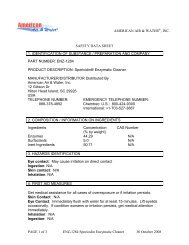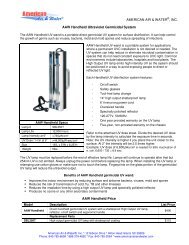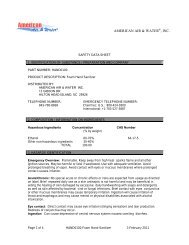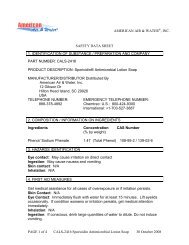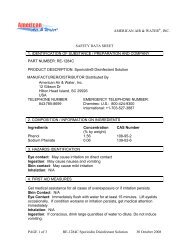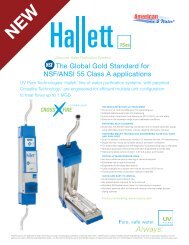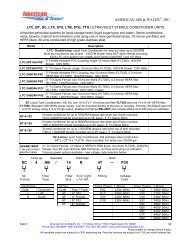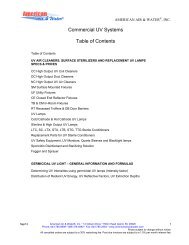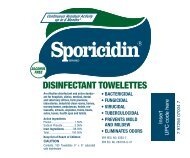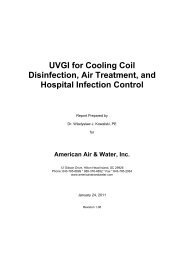Using Ultraviolet Radiation and Ventilation to Control Tuberculosis
Using Ultraviolet Radiation and Ventilation to Control Tuberculosis
Using Ultraviolet Radiation and Ventilation to Control Tuberculosis
You also want an ePaper? Increase the reach of your titles
YUMPU automatically turns print PDFs into web optimized ePapers that Google loves.
<strong>Using</strong><br />
<strong>Ultraviolet</strong> <strong>Radiation</strong><br />
<strong>and</strong> <strong>Ventilation</strong><br />
<strong>to</strong> <strong>Control</strong><br />
<strong>Tuberculosis</strong><br />
Prepared by the<br />
California Indoor Air Quality Program,<br />
Air <strong>and</strong> Industrial Hygiene Labora<strong>to</strong>ry,<br />
<strong>and</strong> <strong>Tuberculosis</strong> <strong>Control</strong><br />
<strong>and</strong> Refugee Health Programs Unit,<br />
Infectious Diseases Branch<br />
Kenneth W. Kizer, M.D., M.P.H., Direc<strong>to</strong>r<br />
Department of Health Services<br />
1990<br />
1
PREFACE<br />
This booklet was produced in response <strong>to</strong> a need expressed by many tuberculosis control<br />
officials for a technically oriented, practical guide <strong>to</strong> the use of ultraviolet light <strong>and</strong><br />
ventilation <strong>to</strong> control tuberculosis transmission. Application of the techniques presented is<br />
best done as a collaborative effort among tuberculosis control personnel, environmental<br />
health <strong>and</strong> safety personnel, <strong>and</strong> physical plant management personnel.<br />
A conscious attempt was made <strong>to</strong> make the information consistent with current<br />
occupational health <strong>and</strong> safety requirements applicable <strong>to</strong> these situations. However, the<br />
specifics of laws <strong>and</strong> regulations are constantly evolving. To assure legal compliance, the<br />
prudent course is <strong>to</strong> consult local occupational health officials.<br />
Members of the California <strong>Tuberculosis</strong> <strong>Control</strong>lers Association, The American<br />
Biological Safety Association, the Center for Infectious Diseases <strong>and</strong> the National Institute<br />
for Occupational Safety <strong>and</strong> Health of the Centers for Disease <strong>Control</strong> reviewed the<br />
material in this booklet. Many individuals gave generously of their time in providing<br />
comments. The successful evolution of the "booklet project" from idea <strong>to</strong> the reality of<br />
this document results directly from the persistent <strong>and</strong> skilled efforts of three individuals:<br />
Janet Macher, Sc. D., M.P.H., Project Direc<strong>to</strong>r, Leon Alevantis, P.E., M.S. from the<br />
California State Air Industrial Hygiene Labora<strong>to</strong>ry <strong>and</strong> Stanley A. Morita, Associate Project<br />
Direc<strong>to</strong>r, from the California State <strong>Tuberculosis</strong> <strong>Control</strong> <strong>and</strong> Refugee Health Programs Unit.<br />
Barry S. Dorfman, M.D., M.P.H<br />
Chief, <strong>Tuberculosis</strong> <strong>Control</strong> <strong>and</strong><br />
Refugee Health Programs Unit<br />
The California Department of Health Services strives <strong>to</strong> provide accurate, complete, <strong>and</strong><br />
useful information <strong>to</strong> the people of the State of California. However, neither the<br />
Department nor any person contributing <strong>to</strong> or assisting in the preparation of this booklet -<br />
nor any person acting on the behalf of any of these parties - makes any warranty,<br />
guarantee, or representation (expressed or implied) with respect <strong>to</strong> the usefulness or<br />
effectiveness of any information, method, or process disclosed in this material, or assumes<br />
any liability for the use of, or for damages arising from the use of, any information,<br />
method, or process disclosed in this material.<br />
Permission <strong>to</strong> reproduce this booklet is granted, provided that credit is given <strong>to</strong> the source<br />
<strong>and</strong> that the material is reproduced without additions or deletions.<br />
The figures for this booklet were drawn by Hazel Anderholm.<br />
2
USING ULTRAVIOLET RADIATION<br />
AND VENTILATION<br />
TO CONTROL TUBERCULOSIS<br />
Contents<br />
I. INTRODUCTION<br />
• How <strong>Tuberculosis</strong> Spreads<br />
• Environmental <strong>Control</strong> Measures<br />
II. ULTRAVIOLET RADIATION<br />
• Questions <strong>and</strong> Answers on the Use of UV <strong>Radiation</strong> for<br />
TB <strong>Control</strong><br />
• Technical Details About UV <strong>Radiation</strong><br />
III. VENTILATION<br />
• Local Exhaust <strong>Ventilation</strong><br />
• Dilution <strong>Ventilation</strong><br />
• Room Air Distribution<br />
• Calculating the Number of Room Air Changes per Hour<br />
• Supplying Make-up Air<br />
IV. REFERENCES<br />
3
I. INTRODUCTION<br />
<strong>Tuberculosis</strong> (TB) Infection <strong>and</strong> Disease remains a world-wide burden despite efforts <strong>to</strong><br />
identify <strong>and</strong> treat cases. After many years of slow but steady decrease in the incidence of<br />
TB in the United States, this disease is making a comeback. It is a serious public health<br />
problem among the homeless, some groups of immigrants, inmates of correctional<br />
institutions, <strong>and</strong> people infected with or at high risk for infection with the human<br />
immunodeficiency virus (HIV). Concerns about the continued spread of TB infection<br />
have led <strong>to</strong> an increased interest in using environmental control measures <strong>to</strong> protect the<br />
above-mentioned groups of people, health care personnel, <strong>and</strong> the general public from TB<br />
infection <strong>and</strong> disease.<br />
How <strong>Tuberculosis</strong> Spreads<br />
TB is spread (transmitted) from person <strong>to</strong> person by tiny airborne particles containing<br />
tubercle bacilli. Particles, called "droplet nuclei," containing these bacteria are coughed<br />
up by persons with untreated or inadequately treated, clinically-active, pulmonary or<br />
laryngeal TB. Droplet nuclei are carried on air currents <strong>and</strong> disperse rapidly throughout a<br />
room. The longer that a susceptible (uninfected) person shares the same air space with<br />
someone who has active pulmonary or laryngeal TB, the greater the chance that the<br />
person will inhale airborne TB bacilli. Therefore, the goal of environmental infection<br />
control is <strong>to</strong> prevent the spread of TB by protecting susceptible people from inhaling<br />
airborne particles generated by infectious individuals.<br />
Environmental <strong>Control</strong> Measures<br />
Airborne infections such as TB can be prevented by killing the infectious microorganisms<br />
in the air with ultraviolet (UV) radiation. UV lamps are inexpensive, easy <strong>to</strong> install <strong>and</strong><br />
maintain, <strong>and</strong> are effective at killing airborne microorganisms. Therefore, some health<br />
authorities recommend UV lamps for certain high risk environments.<br />
Some frequently-asked questions about the use of UV radiation for reducing the spread of<br />
TB are answered in the first part of Section II, <strong>and</strong> a brief technical description of UV<br />
radiation is given in the second part of that section. The spread of airborne infections also<br />
can be reduced with proper ventilation, as discussed in Section III.<br />
Although environmental control measures such as air disinfection <strong>and</strong> ventilation can<br />
decrease the transmission (i.e., airborne spread) of TB, they are only supplements <strong>to</strong> the<br />
usual control measures. Environmental controls cannot replace conventional<br />
interventions such as the prompt detection <strong>and</strong> treatment of cases, <strong>and</strong> tracing of contacts.<br />
However, if the identification <strong>and</strong> follow-up of TB cases is difficult, UV air disinfection<br />
<strong>and</strong> exhaust ventilation can provide an extra measure of protection.<br />
4
II. ULTRAVIOLET RADIATION<br />
Questions <strong>and</strong> Answers on the Use of<br />
UV <strong>Radiation</strong> for TB <strong>Control</strong><br />
How are UV lamps used <strong>to</strong> disinfect the air<br />
Germicidal UV lamps (low-pressure mercury vapor lamps which emit radiation near 254<br />
nanometers) can be used in ceiling fixtures suspended above the people in a room or within<br />
air ducts of recirculating systems. The first method is called overhead or upper air<br />
irradiation. The fixtures are shielded on the bot<strong>to</strong>ms so that the radiation is directed only up<br />
<strong>to</strong>ward the ceiling <strong>and</strong> out <strong>to</strong> the sides (see Figure 1). The bot<strong>to</strong>ms of the fixtures should be at<br />
least 7 feet above the floor so that people will not bump in<strong>to</strong> them or look directly at the bare<br />
tubes (1,2,16). Overhead UV lamps are most effective in rooms in which the ceilings<br />
are at least 9 feet high because this allows a significant portion of the air <strong>to</strong> be<br />
irradiated. Fixtures with adjustable louvers which control the direction of the UV rays<br />
may be used (with caution) in areas with lower ceilings.<br />
Figure 1<br />
Examples of shielded UV fixtures:<br />
a) ceiling-mounted fixture<br />
b) wall-mounted fixture<br />
(the arrows indicate the direction of the radiation)<br />
The air entering or leaving a room can be disinfected with UV lamps placed inside the<br />
ventilation system ducts, as illustrated in Figure 2. This method of air disinfection could<br />
be used, for example, in a TB clinic from which air is recirculated <strong>to</strong> other parts of the<br />
building, but in which overhead disinfection cannot be used because the ceiling is <strong>to</strong>o low.<br />
UV lamps could be placed instead inside the exhaust duct <strong>to</strong> kill any microorganisms in<br />
the air leaving the clinic. Because people are not exposed <strong>to</strong> the UV radiation, very high<br />
levels can be used inside ducts.<br />
5
How effective is UV radiation at killing TB bacteria<br />
The following fac<strong>to</strong>rs, which are discussed in detail below, play a part in determining<br />
whether or not exposure <strong>to</strong> UV radiation will kill a microorganism:<br />
1) the type of microorganism,<br />
2) the dose of radiation <strong>to</strong> which it is exposed, <strong>and</strong><br />
3) the amount of moisture in the air.<br />
1) Type of microoroganism: UV radiation rapidly kills airborne bacteria <strong>and</strong> viruses, but<br />
it is less effective against airborne fungal <strong>and</strong> bacterial spores. The bacteria that cause TB are<br />
more resistant <strong>to</strong> UV than some others, but they are not as difficult <strong>to</strong> kill as spores. UV<br />
radiation does not penetrate well through matter, therefore, bacteria carried in large particles<br />
of dried sputum, for example, might be shielded from the disinfecting radiation. However,<br />
these larger particles do not remain suspended in the air for very long nor do they reach the<br />
lower lung if inhaled, <strong>and</strong> therefore do not pose as great a risk of infection as do smaller,<br />
more UV-sensitive particles.<br />
2) <strong>Radiation</strong> dose: For air disinfection <strong>to</strong> be effective, the TB bacteria must receive a<br />
sufficient dose of UV radiation. This can be achieved by using lamps of the correct<br />
wavelength <strong>and</strong> intensity (wattage) <strong>and</strong> by exposing the bacteria for sufficiently long<br />
periods of time. There must be good mixing between the irradiated upper room air <strong>and</strong> the air<br />
lower in a room where people are. In this way, contaminated droplets are moved in<strong>to</strong> the<br />
irradiated zone <strong>and</strong> the disinfected air dilutes the contaminated lower air. Portable or<br />
ceiling fans can be used <strong>to</strong> increase air circulation.<br />
3) Moisture in the air: At typical indoor temperatures, relative humidities above 70%<br />
reduce the bactericidal efficiency of UV radiation. This level of moisture is not common<br />
in air-conditioned buildings (unless the air-conditioning equipment is not operating<br />
properly) or during the colder months of the year when airborne transmission is more likely.<br />
However, if excess humidity is a problem, air disinfection must exclusively rely on other<br />
forms of environmental control, such as increased ventilation or duct irradiation.<br />
6
For what types of facilities should overhead UV radiation be considered as a means <strong>to</strong><br />
reduce the transmission of infection<br />
Overhead UV lamps are useful in crowded <strong>and</strong> poorly-ventilated buildings where the<br />
conventional control methods are inadequate. Examples of such areas are:<br />
Shelters for the homeless (3),<br />
Correctional institutions (4),<br />
Nursing homes,<br />
Hospitals: emergency rooms, operating rooms, intensive care areas, labora<strong>to</strong>ries,<br />
TB clinics: sputum collection rooms, aerosol treatment areas, ronchoscopy rooms,<br />
AIDS clinics, aerosol pentamidine treatment areas.(5)(17).<br />
In such places, there occasionally are unidentified TB cases. UV lamps also might be<br />
appropriate in pediatricians' offices where the disinfecting radiation would help<br />
control the transmission of other airborne infections such as measles.<br />
Is the airborne spread of TB in high risk settings best controlled by mechanical<br />
ventilation, air cleaners, or UV air disinfection<br />
The American Society of Heating, Refrigerating <strong>and</strong> Air-conditioning Engineers<br />
(ASHRAE) recommends an outdoor air supply of 15 <strong>to</strong> 20 cubic feet of air per minute for<br />
each person in a room (15-20 cfm/person) for comfort purposes (6). However, this amount<br />
of ventilation would not significantly reduce the number of airborne TB bacteria that a<br />
highly infectious person could produce. It would take more than 100 cfm/person of<br />
outdoor air <strong>to</strong> reduce the number of airborne bacteria <strong>to</strong> the same level that a UV lamp<br />
could (1,2,16). Supplying that much outdoor air would be impractical in many situations,<br />
because it is very expensive <strong>to</strong> heat or cool such large quantities of outdoor air <strong>and</strong> <strong>to</strong><br />
move it through a ventilation system.<br />
Indoor air that might contain infectious particles cannot safely be recirculated back<br />
in<strong>to</strong> a room unless the airborne microorganisms have been removed or inactivated.<br />
Filtering the air, installing UV lamps inside the air ducts, <strong>and</strong> other forms of air cleaning<br />
can effectively remove or kill bacteria <strong>and</strong> are suitable, or even necessary, in certain<br />
facilities. However, high-efficiency air cleaners are more expensive <strong>to</strong> install <strong>and</strong> maintain<br />
than overhead UV lamps, <strong>and</strong> generally are not practical for treating the air in large open<br />
rooms. See Section III of this booklet for more details on the use of general <strong>and</strong> local<br />
exhaust ventilation for the control of TB.<br />
7
It is often best <strong>to</strong> design a ventilation system <strong>to</strong> provide at least 15 cfm/person for<br />
comfort, <strong>to</strong> use exhaust hoods <strong>and</strong> special booths <strong>to</strong> contain airborne particles<br />
produced by high risk procedures, <strong>and</strong> <strong>to</strong> consider using overhead UV radiation <strong>to</strong><br />
further reduce the airborne spread of infectious particles.<br />
Checklist of features <strong>to</strong> consider before recommending<br />
overhead UV air disinfection.<br />
Yes No<br />
A potentially high risk of TB transmission in<br />
population that cannot be controlled ( ) ( )<br />
adequately by conventional interventions<br />
Sufficiently high ceilings (at least 9 ft) that ( ) ( )<br />
are relatively free of obstructions.<br />
Relative humidity below 70% ( ) ( )<br />
The capability of maintaining <strong>and</strong> operating<br />
the UV lamps effectively <strong>and</strong> safely ( ) ( )<br />
A means of measuring the reduction in airborne<br />
infections among the occupants ( ) ( )<br />
If the answer <strong>to</strong> any of the above questions is "no," overhead UV disinfection might not be<br />
suitable for the proposed situation.<br />
How are UV lamps used inside heating, ventilating, <strong>and</strong> airconditioning (HVAC)<br />
system ducts<br />
When duct irradiation is used, the lamps should be placed at right angles <strong>to</strong> the<br />
direction of airflow <strong>and</strong> installed at the center of the longest available run, as illustrated<br />
in Figure 2. Because the effectiveness of germicidal UV radiation is dependent on<br />
both the level of radiation <strong>and</strong> the exposure time, it is best, whenever possible, <strong>to</strong> install<br />
UV lamps where the velocity of the air is lowest.<br />
The access door for servicing the lamps should have an inspection window (ordinary<br />
glass is sufficient <strong>to</strong> filter out the UV rays) through which the lamps periodically are<br />
checked <strong>and</strong> a sign in appropriate languages alerting maintenance personnel <strong>to</strong> the<br />
health hazard of looking directly at bare tubes. The lock for this door should have an<br />
electric switch so that the lamps turn off au<strong>to</strong>matically whenever the door is opened.<br />
8
How do I decide how many overhead UV lamps an area needs<br />
The number of fixtures needed depends on the size of the room, the height of the<br />
ceilings, <strong>and</strong> the location of the supply air diffusers. The higher the UV radiation<br />
intensity, the more rapidly microorganisms are inactivated. Threrefore, the more<br />
lamps the better so long as human exposure <strong>to</strong> UV is kept at safe levels. As a general<br />
rule of thumb, install the equivalent of one 30 watt fixture for every 200 ft'- of floor area or<br />
for every seven people in the room, whichever is greater. <strong>Using</strong> two 15 watt lamps<br />
instead of one 30 watt lamp might provide better irradiation of the upper room air <strong>and</strong><br />
reduce the risk of exposing the occupants <strong>to</strong> unsafe levels of UV radiation. This amount of<br />
air disinfection is considered the equivalent of 20 room air changes per hour (ACH) or<br />
approximately 100 cfm/person (i,2). Ceiling fixtures should be oriented so that the<br />
radiation is directed in<strong>to</strong> the longest part of a room (see Figure 3, below). If multiple<br />
fixtures are installed, they should be spaced evenly so that there is minimal overlap of<br />
irradiation.<br />
9
Can upper air UV irradiation cause any problems<br />
UV radiation is divided in<strong>to</strong> three regions. UV-A (long UV 400-320nm), <strong>and</strong> UV-B<br />
(midrange UV 320-290nm) that produce sunburn <strong>and</strong> tanning. Prolonged exposure can<br />
cause skin cancer <strong>and</strong> cataracts (7). Germicidal UV radiation is in the UV -C region of<br />
the spectrum (short UV, 290-100nm).UV C may cause reddening of the skin <strong>and</strong><br />
conjunctivitis (a feeling of s<strong>and</strong> in the eyes), but not skin cancer or cataracts in humans (8).<br />
Because UV-C is absorbed in the outer layers of the skin <strong>and</strong> eyes, the irritation produced<br />
by overexposure is superficial. Although serious burns can be incapacitating at the time, the<br />
effects usually disappear within 24 hours without lasting effects (8).<br />
Intense UV radiation can fade colored paints <strong>and</strong> fabrics, speed up the deterioration of<br />
plastics, <strong>and</strong> cause plants <strong>to</strong> wilt. Because prolonged exposure <strong>to</strong> UV radiation can<br />
damage skin <strong>and</strong> eyes, one should never look directly at the lighted tubes for more than a few<br />
seconds unless wearing appropriate safety goggles or a face shield. Also, one should<br />
wear a long-sleeved shirt <strong>and</strong> gloves if it is necessary <strong>to</strong> work near lighted lamps.<br />
Maintenance personnel should exercise appropriate precautions against breakage when<br />
replacing <strong>and</strong> disposing of these tubes. Modern UV lamps do not produce ozone.<br />
It also must be remembered that UV lamps produce some visible violet light. While the<br />
color is scarcely noticeable during the day, at night it might disturb people who are trying <strong>to</strong><br />
sleep. Nonetheless, the lamps should be operated whenever people occupy the controlled<br />
rooms. In buildings that are occupied all day, the UV lamps should be left on continuously.<br />
Frequent on-off cycling tends <strong>to</strong> shorten the life of some types of lamps.<br />
A person should be assigned responsibility <strong>to</strong> maintain the UV fixtures, train in safety<br />
procedures <strong>and</strong> keep a maintenance log. A maintenance <strong>and</strong> safety log should include<br />
information on tube cleaning, baseline <strong>and</strong> periodic meter readings for irradiation areas<br />
(between lamp <strong>and</strong> ceiling) <strong>and</strong> for employee/client exposure areas, training, <strong>and</strong> complaints<br />
of eye or skin irritation. There is no substitute for on-site meter readings <strong>to</strong> assure that<br />
germicidal levels are attained between tubes <strong>and</strong> ceilings or walls while at the same time<br />
room occupants are not exposed <strong>to</strong> injurious levels. Employees should be trained on the<br />
hazards of exposure <strong>to</strong> UV radiation. This training should include:<br />
1. Information as <strong>to</strong> the proper eye protection <strong>and</strong> protective clothing <strong>to</strong> be used.<br />
2. Instructions on how <strong>to</strong> recognize the symp<strong>to</strong>ms of eye <strong>and</strong> skin damage due <strong>to</strong> UV<br />
radiation.<br />
How can I be sure that new UV lamps have been installed safely<br />
When the lamps are installed, an experienced person should measure the level of UV<br />
radiation at the locations where people will be exposed. All readings must be below the<br />
American Conference of Government Industrial Hygienists' (ACGIH) limit, which<br />
for germicidal lamps is 0.2 microwatts per square centimeter (µW/cm 2 ) for an 8-hour<br />
10
period (8). If you plan on purchasing a UV radiometer, make certain that it can measure<br />
the necessary range of wave lengths <strong>and</strong> is sufficiently sensitive.<br />
The exposure limit refers <strong>to</strong> 254-nm UV radiation which is the predominant wavelength<br />
produced by germicidal lamps. The permitted exposure limit is 6 milli-<br />
Joules/cm= or 6000µW • seconds/cm². For an 8-hour day, the average exposure level<br />
limit is 0.2µW/cm². For 24 hour exposure, the limit would be 0.07µW/cm². To reduce<br />
UV exposure in the occupied portions of a room, install baffles <strong>to</strong> prevent people<br />
from looking directly at the tubes. If necessary, use paints containing titanium<br />
dioxide (Ti02) <strong>to</strong> reduce reflection from ceilings <strong>and</strong> walls, or otherwise treat them<br />
<strong>to</strong> reduce reflection. Once a room has been checked <strong>to</strong> assure that all occupied areas<br />
are below the NIOSH exposure limit, these measurements do not need <strong>to</strong> be repeated<br />
every time the lamps are changed.<br />
If the UV lamp manufacturer or installer does not supply warning labels, make or<br />
purchase your own <strong>to</strong> identify the fixtures as dangerous for direct eye <strong>and</strong> prolonged<br />
skin exposure. Figure 4 is a sample warning label recommended by NIOSH (8). The<br />
NIOSH document also states that for this type of lamp, warning labels are required on the<br />
lamp <strong>and</strong> housing, but not in the work area. Make certain that the switches <strong>to</strong> turn the<br />
UV fixtures off for inspection, cleaning, <strong>and</strong> tube changing are accessible when<br />
needed but are out of the reach of unauthorized people so that the lamps cannot be<br />
turned on or off accidentally.<br />
Figure 4<br />
Warning labels<br />
11
How often must the tubes be changed<br />
Unless a facility has an appropriate radiometer <strong>and</strong> a trained staff member who can check<br />
lamp output periodically, we recommend that the tubes be replaced each year or at the<br />
end of their rated life if that is less than twelve months.<br />
How often must the lamps be cleaned<br />
The tubes <strong>and</strong> the fixture trough should be checked periodically (perhaps every three<br />
months) <strong>and</strong> cleaned when needed. We do not recommend frequent lamp readings or<br />
cleaning, unless performed by a properly trained <strong>and</strong> equipped person, because of the risk<br />
of accidents.<br />
How much does it cost <strong>to</strong> use overhead UV air disinfection<br />
New UV fixtures cost between $100 <strong>and</strong> $500, depending on their design, <strong>and</strong> new lamps<br />
cost between $50 <strong>and</strong> $100 per tube. You can estimate how much it will cost <strong>to</strong> operate a<br />
lamp continuously for one year by multiplying the input wattage by the number of hours of<br />
use (8760 hours for one year) <strong>and</strong> the local cost of electricity (see the formula below). UV<br />
lamps should be purchased as they are needed, because prolonged s<strong>to</strong>rage results in a loss<br />
of UV intensity.<br />
input wattage x hours of use x cost = operation cost<br />
1000W/Kilowatt<br />
Kilowatt-hour<br />
Where can I find someone <strong>to</strong> install germicidal UV fixtures<br />
You may be able <strong>to</strong> locate suppliers by contacting your local health department, a hospital,<br />
or microbiology labora<strong>to</strong>ry since these entities may already have experience of their own<br />
with UV fixtures. Prior <strong>to</strong> purchase <strong>and</strong> installation of tubes <strong>and</strong>/or fixtures, you should<br />
review the information in this booklet with your supplier <strong>and</strong>/or installer <strong>to</strong> ensure that<br />
appropriate fixtures are provided <strong>and</strong> properly installed. If your supplier/installer has not<br />
recently been involved in these types of installations, familiarization with the material in<br />
this booklet, especially as it pertains <strong>to</strong> safety, is all the more important.<br />
12
The main recommendations of this section are summarized below.<br />
Suggestions on the Proper Use of<br />
Upper Air UV Irradiation.<br />
1. Use germicidal lamps that emit short wave (254 nm) ultraviolet radiation.<br />
2. Install the equivalent of one 30W ceiling or wall fixture for every 200 ft² of floor<br />
area or for every seven people in a room, whichever is greater. Always check that<br />
your installation does not exceed safe exposure levels for workers or clients.<br />
3. Position the lamps <strong>to</strong> irradiate the greatest area.<br />
4. Place labels on the fixtures <strong>to</strong> warm people <strong>to</strong> avoid direct eye <strong>and</strong> prolonged skin<br />
exposure.<br />
5. Check that the level of ultraviolet radiation where people will be exposed does<br />
not exceed 0.2µW/cm² (assumes an 8-hour exposure). Recheck whenever<br />
reflective surfaces or room contents are changed.<br />
6. Change the tubes annually or when meter readings indicate tube failure.<br />
7. Inform all employees of the potential hazards of overexposure <strong>to</strong> UV<br />
radiation <strong>and</strong> provide adequate personal protection <strong>to</strong> anyone who needs it<br />
8. Delegate a person <strong>to</strong> maintain the lamps, <strong>to</strong> see that safety measures are followed <strong>and</strong><br />
<strong>to</strong> keep a log of when the lamp are replaced<br />
13
Technical Details About UV <strong>Radiation</strong><br />
As mentioned previously, UV radiation is divided in<strong>to</strong> three regions by wavelength: long,<br />
middle, <strong>and</strong> short waves. UV radiation for the purpose of killing microorganisms is produced<br />
by lamps that emit radiation in the short wave region near 254 nanometers (there are 25<br />
million nanometers in an inch), which is near the peak of bactericidal<br />
effectiveness. All UV wavelengths are shorter than visible light, therefore, UV rays are<br />
invisible <strong>to</strong> the human eye <strong>and</strong> should be referred <strong>to</strong> as UV radiation or UV energy, not as UV<br />
light. However, UV lamps also emit a small amount of visible violet-blue light.<br />
Two important principles (the reciprocity <strong>and</strong> the inverse square laws), which are helpful in<br />
underst<strong>and</strong>ing how UV lamps can be used for air disinfection, are discussed below.<br />
Reciprocity law: The dose of radiation <strong>to</strong> which microorganisms are exposed is equal <strong>to</strong> the<br />
intensity of the radiation times the duration of exposure. Equal doses of UV radiation have<br />
the same disinfecting action. Therefore, exposure <strong>to</strong> 100 microwatts per square centimeter<br />
(µW/cm²) for 10 seconds has the same killing power as exposure <strong>to</strong> 50µW/cm² - for 20<br />
seconds.<br />
Inverse square law: As with visible light, the intensity of UV radiation diminishes as the<br />
square of the distance from a source. For example, two feet from a point source the intensity of<br />
the radiation would be only (1/2) 2 or 1/4 of what it was at one foot, <strong>and</strong> at four feet it would be<br />
(1/4) 2 or 1/16 of the level at one foot.<br />
Distance from Measured<br />
UV source UV intensity<br />
(ft)<br />
(µW/cm²)<br />
_________ ___________<br />
1 800<br />
2 200<br />
4 50<br />
Because UV lamps are long narrow sources of radiation rather than point sources, it is<br />
difficult <strong>to</strong> predict the UV intensity at a given distance from a lamp. Therefore, it is more<br />
reliable <strong>to</strong> measure the actual exposure level with a sufficiently sensitive UV meter.<br />
14
III. ULTRAVIOLET RADIATION<br />
The concentrations of contaminants in a room can be controlled with mechanical ventilation<br />
in two ways. The first is called local exhaust ventilation. The second is referred <strong>to</strong> as<br />
dilution ventilation. These methods are described below.<br />
Local Exhaust <strong>Ventilation</strong><br />
A local exhaust ventilation system removes airborne contaminants at or near<br />
their sources <strong>and</strong> can contain infectious aerosols very effectively. An example would be the<br />
safety hoods that labora<strong>to</strong>ry workers use when h<strong>and</strong>ling specimens. Similar enclosures<br />
often are used for aerosol-generating activities such as sputum collection <strong>and</strong> aerosol<br />
therapy. Detailed information on the design of local exhaust systems is available in<br />
Industrial <strong>Ventilation</strong>. A Manual of Recommended Practice (10).<br />
The major components of a local exhaust ventilation system are: 1) the hood or enclosure, 2)<br />
the ductwork through which the air moves, 3) an air cleaner, <strong>and</strong> 4) the fan (see Figure 5).<br />
An air cleaner, such as a high-efficiency air filter, a UV lamp, or an air incinera<strong>to</strong>r, is<br />
needed when the contaminated air cannot be exhausted safely or is recirculated <strong>to</strong> a room.<br />
15
The booth illustrated in Figure 6 is designed for use during sputum induction or<br />
aerosolized pentamidine treatment. Patients enter the booth through a door in the side <strong>and</strong><br />
either sit or lie on a bench. Air is drawn in<strong>to</strong> the chamber through a pre-filter (l) located in<br />
the front, then moves up past the patient <strong>and</strong> over the <strong>to</strong>p of a back panel (2). The air is<br />
filtered through a HEPA (high efficiency particulate air) filter (3) before it is exhausted<br />
back in<strong>to</strong> a room (4).<br />
Also on the market are vinyl chambers that isolate the patient in an enclosure similar <strong>to</strong> an<br />
oxygen tent canopy. The canopy falls <strong>to</strong> within 2 inches from the floor. The air is drawn<br />
upward from the open area around the skirt <strong>and</strong> exhausted from the enclosure by a fan<br />
through a HEPA filter. The chamber is collapsible, conveniently sized so that it takes little<br />
space <strong>and</strong> is on wheels for increased mobility.<br />
Dilution <strong>Ventilation</strong><br />
Dilution ventilation is a process of supplying pollutant-free air in<strong>to</strong> a space <strong>to</strong> reduce the<br />
level of contamination. Some ventilation systems provide 100% outdoor air <strong>and</strong> exhaust all<br />
return air. Other systems, in the interest of energy conservation, recirculate part of the return<br />
air.<br />
If a ventilation system is used <strong>to</strong> protect people from infectious particles, the system must<br />
draw the contaminated air away from the people in the room <strong>and</strong> carry it safely outside.<br />
The American Institute of Architects (AIA) has developed construction <strong>and</strong> operation<br />
guidelines for hospitals <strong>and</strong> medical facilities (11). A design that they recommend for<br />
reducing exposure <strong>to</strong> air contaminants generated by people is <strong>to</strong> place the air supply<br />
diffusers in the ceiling <strong>and</strong> the exhaust air grilles (also called registers) near the floor (see<br />
Figure 7). The idea behind this arrangement is that clean air enters above the occupants <strong>and</strong><br />
contaminated air is removed at floor level. This design would not be appropriate if overhead<br />
UV lamps were being used because the contaminated air would be directed away from the<br />
lamps. When overhead UV lamps are used, the supply air diffusers should be near the<br />
floor, <strong>and</strong> the exhaust air grilles near or in the ceiling.<br />
16
Contaminated air removed from a room should not be recirculated back in<strong>to</strong> the room or <strong>to</strong><br />
other parts of a building unless it passes through a high efficiency filter, or an air incinera<strong>to</strong>r,<br />
past a high intensity UV lamp, or is otherwise disinfected. Untreated exhaust air should<br />
be discharged well away (at least 25 ft) <strong>and</strong> downwind from the air intakes of any buildings<br />
(io). Air often is exhausted at the roof of a building so that any contaminants it contains are<br />
well diluted before they reach street level. Detailed guidelines for designing ventilation<br />
systems for infection control can be obtained from the AIA (11) <strong>and</strong> from the ASHRAE(6).<br />
Room Air Distribution<br />
Short circuiting of air. If a supply air diffuser is only a few feet away from a return air<br />
grille, part of the supply air will be exhausted before it mixes with the air in the room.<br />
This is called "short circuiting."<br />
Air stagnation. Given average room air movement <strong>and</strong> the non-uniformity of natural<br />
convection currents, stagnant regions are formed in a room near the ceiling during<br />
cooling <strong>and</strong> near the floor during heating. The air in a stagnant region does not mix well<br />
with the air in the rest of the room.<br />
Air mixing. The mixing of supply air with the air in a room is affected by:<br />
1) the configuration of the supply air diffusers <strong>and</strong> the return air grilles,<br />
2) the volume of air supplied <strong>to</strong> the room, <strong>and</strong><br />
3) the operating mode of the ventilation system, that is, whether it is<br />
heating or cooling the air.<br />
Calculating the Number of Room Air Changes per Hour<br />
Engineers sometimes express dilution ventilation in terms of the air change rate, which is<br />
measured as the number of room air changes per hour (ACH). An air change rate of 1 ACH<br />
means that an amount of air equal <strong>to</strong> the volume of the room is removed <strong>and</strong> replaced one<br />
every hour. Reference 17 cites the American Society of Heating, Refrigerating <strong>and</strong><br />
Air-conditioning Engineers <strong>and</strong> the Health Resources <strong>and</strong> Services Administration (our<br />
17
eference 11) as recommending that acid-fast bacilli isolation rooms: "...should have at<br />
least six <strong>to</strong>tal air changes per hour, including at least two outside air changes per hour..."<br />
A facility could meet this recommendation by supplying 4 ACH of air recirculated from other<br />
parts of the building <strong>and</strong> 2 ACH of outdoor air. Reference 17 also gives ventilation<br />
recommendations for intensive care units <strong>and</strong> emergency <strong>and</strong> au<strong>to</strong>psy rooms, <strong>and</strong> discusses<br />
the use of personal respira<strong>to</strong>rs of patients while they are being transported <strong>and</strong> for health<br />
care providers while they are treating patients with suspected or confirmed infectious<br />
tuberculosis. Although an air change rate as high as 20 ACH may be desirable in high risk<br />
areas <strong>and</strong> has been recommended in earlier documents, we realize that this level of<br />
ventilation is impractical for many facilities <strong>and</strong> that the resultant air movement may cause<br />
drafts.<br />
For a given air change rate <strong>and</strong> room size, the required amount of supply air in cubic feet per<br />
minute (cfm) can be calculated, as follows:<br />
(room volume in cubic feet) x (number of ACH) = CFM<br />
60 min/hour<br />
For example, a 20 ft by 10 ft room with a 10 ft ceiling would need 667 cfm of supply air <strong>to</strong><br />
have an air change rate of 20 ACH:<br />
(20ft x10ft x l0ft) x (20ACH) = 667<br />
60 min/hour<br />
You can find out what the design airflow rates are for a given area by asking the build<br />
ing manager <strong>to</strong> check the original plans. The opera<strong>to</strong>r of your heating, ventilating, <strong>and</strong><br />
air-conditioning (HVAC) system or a contrac<strong>to</strong>r can determine the actual supply airflow rate<br />
for a particular room by measuring it with special instruments.<br />
As mentioned in the first part of Section II, ASHRAE recommends a ventilation rate of at<br />
least 15 cubic feet of outdoor air per minute per person (15 cfm/person) for comfort (6). The<br />
ASHRAE st<strong>and</strong>ard assumes that there are 10 persons/1000 ft² in hospital treatment rooms, <strong>and</strong><br />
30 persons/1000 ft² in lobby areas. In a well-designed facility, 15 cfm/person will<br />
sufficiently dilute the odors that people produce, but it should no be relied on <strong>to</strong> reduce<br />
exposure <strong>to</strong> highly infectious air contaminants.<br />
Referring again <strong>to</strong> the 2000 ft 3 room used as an example above, when occupied by seven<br />
people, this room would need a supply of at least 105 cfm outdoor air (7 people x 15<br />
c&n/person=105 cfin) <strong>to</strong> conform with the ASHRAE st<strong>and</strong>ard. However, this would<br />
supply only 3 air changes an hour [(105 cfin x 60 min/hr)/ 2000 ft 3 = 3 ACH]. This<br />
amount of dilution air would not be sufficient <strong>to</strong> control the spread of TB.<br />
For comparison, if the 20 ACH that the CDC/ATS(13) recommends was supplied with<br />
outdoor air, the ventilation rate would have <strong>to</strong> be 95 cfm/person (667 cfm/7 people= 95<br />
cfm/person), an impractically high ventilation rate for most facilities. However, the<br />
equivalent of this amount of TB-free air could be provided with upper air UV disinfection,<br />
as discussed in Section II.<br />
18
Supplying Make-up Air<br />
When an exhaust system is used, air must be supplied <strong>to</strong> the room <strong>to</strong> "make-up" for the<br />
volume removed through the ventilation system or the hood. If the ventilation system is<br />
balanced <strong>to</strong> provide less than the required amount of make-up air, the room will be under<br />
negative pressure. This vacuum will result in the movement of air from cleaner adjacent<br />
rooms in<strong>to</strong> the contaminated room <strong>and</strong> not the reverse. The U. S. Public Health Service<br />
suggests an infiltration rate of 50 cfm for containment labora<strong>to</strong>ries (14) or<br />
approximately 10% of the return air volumetric flowrate (15).<br />
It is important that a building's air supply <strong>and</strong> exhaust systems be designed <strong>to</strong><br />
accomodate the pressure changes caused by the opening <strong>and</strong> closing of doors, <strong>and</strong> by the<br />
movement of staff <strong>and</strong> patients. An instrument <strong>to</strong> measure air pressure (a<br />
manometer) with an audible alarm can be installed <strong>to</strong> warn people if room pressure<br />
changes.<br />
Proper ventilation is an important determinant of a comfortable indoor environment. It<br />
also can provide a measure of protection against airborne infection. Periodic<br />
moni<strong>to</strong>ring <strong>and</strong> maintenance of air supply <strong>and</strong> exhaust systems is necessary for<br />
effective operation. The main recommendations of Section III are summarized below.<br />
Suggestions for Good <strong>Ventilation</strong>.<br />
1. Use local exhaust ventilation (for example, cabinets or booths) <strong>to</strong> contain activities that<br />
generate infectious particles. Use general exhaust ventilation <strong>to</strong> remove contaminated air<br />
from a room, <strong>and</strong> <strong>to</strong> keep the room under negative pressure <strong>to</strong> other areas. Supply at least<br />
the minimum recommended amount of outdoor air.<br />
2. Install supply air diffusers <strong>and</strong> general exhaust air grilles so that contaminated air moves<br />
away from the breathing zones of the people in a room. Make certain that short-circulating<br />
<strong>and</strong> stagnation of air are minimized.<br />
3. Discharge the contaminated air outdoors at least 25 ft away <strong>and</strong> down wind from any<br />
outdoor air intakes. Install high efficiency air filters, UV lamps, or other disinfection units if<br />
the air must be exhausted closer than 25 ft <strong>to</strong> an air intake or if a large percentage of the<br />
potentially contaminated air will be recirculated <strong>to</strong> a building.<br />
In order <strong>to</strong> prevent the transmission of TB <strong>and</strong> other respira<strong>to</strong>ry infections in certain high<br />
risk settings, health care workers are paying increasing attention <strong>to</strong> environmental control<br />
measures. The references listed below provide additional details on the subject. For further<br />
information, contact your local health department or TB control officer; the Indoor Air<br />
Quality Program, Air & Industrial Hygiene Labora<strong>to</strong>ry, California Department of<br />
Health Services, 2151 Berkeley Way, Berkeley, CA 947041011; of the <strong>Tuberculosis</strong><br />
<strong>Control</strong> <strong>and</strong> Refugee Health Programs Units, Infectious Disease Branch, California<br />
Department of Health Services, 714/744 P Street, P.O. Box 942732, Sacramen<strong>to</strong>,<br />
California 94234-7320.<br />
19
IV. REFERENCE<br />
1. Riley, R.L. (1988) <strong>Ultraviolet</strong> air disinfection for control of respira<strong>to</strong>ry contagion. in:<br />
Architectural Design <strong>and</strong> Indoor Microbial Pollution. R. Kundsin, ed. Oxford University Press,<br />
New York, NY pp. 174-197.<br />
2. Riley, R.L. & E. A. Nardell. (1989) Clearing the air: The theory <strong>and</strong> application of ultraviolet air<br />
disinfection. Am. Rev. Respir. Dis. 139:1286-1294.<br />
3. Nardell, E.A. (1988) <strong>Ultraviolet</strong> air disinfection <strong>to</strong> control tuberculosis in a shelter for the<br />
homeless. in: Architectural Design <strong>and</strong> Indoor Microbial Pollution. R. Kundsin, ed. Oxford<br />
University Press, New York, NY pp.296-308.<br />
4. Centers for Disease <strong>Control</strong>. (1989) Prevention <strong>and</strong> control of tuberculosis in correctional<br />
institutions: Recommendations of the Advisory Committee for the Elimination of <strong>Tuberculosis</strong>.<br />
MMWR 38:313-319.<br />
5. U.S. Department of Health <strong>and</strong> Human Services. Public Health Service. Centers for Disease<br />
<strong>Control</strong>. TB/HIV. The Connection: What Health Care Workers Should Know. Atlanta, GA.<br />
6. American Society for Heating, Refrigerating <strong>and</strong> Air-conditioning Engineers (ASHRAE)<br />
St<strong>and</strong>ard 62-1989. <strong>Ventilation</strong> for Acceptable Indoor Air Quality. 1791 Tullie Circle, N.E.,<br />
Atlanta, GA 30329. (404) 636-8400.<br />
7. Tayler, H.R., S.K. West, F.S. Rosenthal, et al. (1988) Effect of <strong>Ultraviolet</strong> radiation on cataract<br />
formation. N. Engl. J. Med. 319:1429-1433.<br />
8. Murray, W.E. (1990) <strong>Ultraviolet</strong> radiation exposure in a mycobacteriology labora<strong>to</strong>ry. Health<br />
Physics 58: 507-510.<br />
9. National Institute for Occupational Safety & Health. (NIOSH), Occupational Exposure <strong>to</strong><br />
<strong>Ultraviolet</strong> <strong>Radiation</strong>. Concinnati, OH 45226.<br />
10. American Conference of Governmental Industrial Hygienists (ACGIH). (1980) Industrial<br />
<strong>Ventilation</strong>. A Manual of Recommended Practice. P.O. Box 16153, Lansing, MI 48901. (513)<br />
661-7881.<br />
11. American Institute of Architects. (1987) Committee on Architecture for Health.<br />
Guidelines for Construction <strong>and</strong> Equipment of Hospital <strong>and</strong> Medical Facilities. Waldorf, MD.<br />
12. Centers for Disease <strong>Control</strong>. (1982) Guidelines for prevention of TB transmission in<br />
hospitals. Atlanta: U.S. Department of Health <strong>and</strong> Human Services, Public Health Service; DHHS<br />
publication no. (CDC)82-8371.<br />
13. Centers for Disease <strong>Control</strong>/American Thoracic Society. (1981) Diagnostic St<strong>and</strong>ards <strong>and</strong><br />
Classification of <strong>Tuberculosis</strong> <strong>and</strong> OtherMycobacterial Diseases. 14th Edition. (Reprinted from<br />
Am. Rev. Respir. Dis.123(3): 343-358).<br />
14. U.S. Public Health Service, (1978) National Institutes of Health Labora<strong>to</strong>ry Safety<br />
Monograph. Supplement <strong>to</strong> the NIH Guidelines for recombinant DNA Research. U.S.<br />
Department of Health, Education <strong>and</strong> Welfare, National Institutes of Health. Bethesda, MD.<br />
15. Woods, J. E. <strong>and</strong> D. R. Rask. (1988) Heating, ventilation, air-conditioning systems: the<br />
engineering approach <strong>to</strong> methods of control. in: Architectural Design <strong>and</strong> Indoor Microbial<br />
Pollution. R. Kundsin, ed. Oxford University Press, New York, NY, p. 142.<br />
16. Stead, W. (1989) Clearing The Air: The Theory <strong>and</strong> Application of <strong>Ultraviolet</strong> Air Disinfection,<br />
Correspondence. The American Review of Respira<strong>to</strong>ry Disease, Vol. 140, No. 6, Page 1832.<br />
17. Centers for Disease <strong>Control</strong>. (1990) Guidelines for Preventing the Transmission of<br />
<strong>Tuberculosis</strong> in Health-Care Settings, with Special Focus on HIV-Related Issues, MMWR Dec. 7,<br />
1990/Vol. 39/No. RR-17.<br />
20


